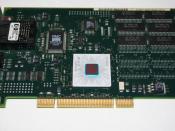Asynchronous Transfer Mode (ATM) Networking Asynchronous Transfer Mode (ATM) is, and will be for many years to come, the top of the line in networking technology. Since the creation of the Network (the ARPAnet (Advanced Research Project Agency Network)) scientists and engineers have strived to achieve the fastest information exchange speeds combined with the most cost-efficient hardware and software. Their products and ideas have always been based on packet technology and turn-based transfers; however, in the 1980s an experimental system called ATM challenged these axioms. The ATM consisted of a new topology - Asynchronism.
ATM is one of many networking types, such as Ethernet and Token Ring, which differs from all networking types in its fundamental methods. Where all other networks use consistent timing to organize the information exchange (this is called Synchronism,) ATMs use start and stop bits to allow information to send itself when needed (Asynchronism.) When the information is allowed to be shipped, it has always been sent in groups of various sizes called packets.
In ATM the information is sent in a standardized size, these uniform groups are called cells.
New networking technology is accepted reluctantly, for choosing to buy yourself or your company a technology that does not become widely accepted means the waste of money, time, and energy. Due to this the users of ATM have been select until very recently. The major users of ATM are universities and research centers - both of who were given government "seed money" for the purpose. The users of ATM are growing very quickly and diversely as the fear of newness rubs off and envy grows toward the original users.
Though the network was the primary application focus when Asynchronism was discovered, ATM networks are not the sole application of Asynchronism. Asynchronism was successfully tested in, and...


